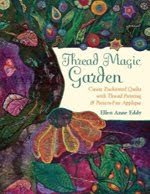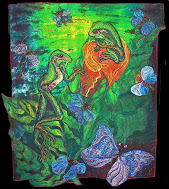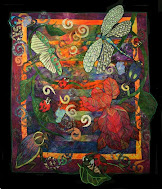Wednesday, June 29, 2011
Designing Ways: Dancing in the Grid
Back to fabric design. We've all watched Dancing with the Stars. Once we're done with that and Steve Goodman, how about Dancing with Butterflies? Remember the Arther Mury patterns on the floor? Basically they were just moving in squares.
Just as an exercise in design, I took a butterfly drawing, colored it and went dancing with it in squares.
As I was playing with the placement, it wasn't long before I recognized that it was just like playing with a triangle quilt design.
Angling the butterflies as triangles and making them different sizes turned them into instant quilt squares. Who knew? Designing fabric is really designing quilts.
I did this in Illustrator, partially because I'm trying to learn the program and it was as good an exercise as any. But it would be so much easier in something like Electric Quilt 7. I flipped them, shrunk them, turned them, and made them dance.
Then I added a curlicue.
Fabric design is rhythmic pattern across a surface. It dances as it repeats itself, in the same patterns or in patterns that reflect or flip the original shape.
Like all dancing, it's endless, built for improvisation, but always in place with it's on rhythms. Am I there yet? I don't think so. I need to practice with Arthur Murry, just a bit more.Want to dance?
Wrapping it up: Designing both quilts and fabric is about rhythmic patterns in and out of a grid.
Find more information about designing fabric on Spoonflower.
Find really cool design software at
Designing Ways: Dancing in the Grid
Back to fabric design. We've all watched Dancing with the Stars. Once we're done with that and Steve Goodman, how about Dancing with Butterflies? Remember the Arther Mury patterns on the floor? Basically they were just moving in squares.
Just as an exercise in design, I took a butterfly drawing, colored it and went dancing with it in squares.
As I was playing with the placement, it wasn't long before I recognized that it was just like playing with a triangle quilt design.
Angling the butterflies as triangles and making them different sizes turned them into instant quilt squares. Who knew? Designing fabric is really designing quilts.
I did this in Illustrator, partially because I'm trying to learn the program and it was as good an exercise as any. But it would be so much easier in something like Electric Quilt 7. I flipped them, shrunk them, turned them, and made them dance.
Then I added a curlicue.
Fabric design is rhythmic pattern across a surface. It dances as it repeats itself, in the same patterns or in patterns that reflect or flip the original shape.
Like all dancing, it's endless, built for improvisation, but always in place with it's on rhythms. Am I there yet? I don't think so. I need to practice with Arthur Murry, just a bit more.Want to dance?
Wrapping it up: Designing both quilts and fabric is about rhythmic patterns in and out of a grid.
Find more information about designing fabric on Spoonflower.
Find really cool design software at
Tuesday, June 28, 2011
Art Outside the Box The Care and Feeding of Quilt Shops #2
I've written about quilt shops before, because I KNOW how vital they are. One of the treasures of getting to visit all over the country is that you get a chance to see all the wonderful little shops.
Now I'm a fan of little shops in general. I believe in small business as the way we hold ourselves together as a society. It's people taking good care of people and it's worthy of support. It's the store where no one tells you that you are the only one that wants an item, that the store only gets what the corporation sends them and that this is just what's in right now, never mind what you really want and/or need. Corporations are not good at customer care.
More than that, it's community. A good quilt store creates your place for information, gorgeous fabric, gossip,the latest tools, good advice, a friendly shoulder and an excellent cackle. In short, it's a place where quilters meet amazing people like themselves.
So a new quilt store, particularly in an area without, is a cause for major celebration. Thread Benders is a brand new quilt store at 613 Franklin Street, downtown Michigan City, Indiana. It features things for quilters of all styles. It's just an hour out of Chicago, and on your way if you're heading up to Michigan for the weekend.Threadbenders will be open from 5-8 pm for the First Friday Michigan City Gallery Walk, July 1st.
For the First Friday Gallery walk, I'll be at Threadbenders, showing off her new Sweet Sixteen longarm. It turns out to do excellent bobbin work. I'm in love.
I'll have quilts, my hand-dyed fabric and threads, and books available. We'll do some raffles of cool things to start out your hot summer sewing. We'll have plenty of brownies and wine to chill down your evening. We'll play with her new handiquilter machines and show them all that, of course! Quilts are ART!
Come join me.
Now I'm a fan of little shops in general. I believe in small business as the way we hold ourselves together as a society. It's people taking good care of people and it's worthy of support. It's the store where no one tells you that you are the only one that wants an item, that the store only gets what the corporation sends them and that this is just what's in right now, never mind what you really want and/or need. Corporations are not good at customer care.
More than that, it's community. A good quilt store creates your place for information, gorgeous fabric, gossip,the latest tools, good advice, a friendly shoulder and an excellent cackle. In short, it's a place where quilters meet amazing people like themselves.
So a new quilt store, particularly in an area without, is a cause for major celebration. Thread Benders is a brand new quilt store at 613 Franklin Street, downtown Michigan City, Indiana. It features things for quilters of all styles. It's just an hour out of Chicago, and on your way if you're heading up to Michigan for the weekend.Threadbenders will be open from 5-8 pm for the First Friday Michigan City Gallery Walk, July 1st.
For the First Friday Gallery walk, I'll be at Threadbenders, showing off her new Sweet Sixteen longarm. It turns out to do excellent bobbin work. I'm in love.
I'll have quilts, my hand-dyed fabric and threads, and books available. We'll do some raffles of cool things to start out your hot summer sewing. We'll have plenty of brownies and wine to chill down your evening. We'll play with her new handiquilter machines and show them all that, of course! Quilts are ART!
Come join me.
Wednesday, June 8, 2011
Designing Ways: Gravity Meets Geometry
What makes a shape move? We acknowledged that graphically on paper, things move strictly in our head. After years of things falling down around us, we can look at shapes at certain angles and say, "Yep. That's falling." We observe that it should be moving, and our mind makes it do that.
So what makes a shape itself mobile(moving) or static(staying still)?
In the same way angles make things move, symmetry makes things stay in place. A square is the ultimate stable shape. Nothing about it suggests movement. Because it's even sides it doesn't even move the eye from the center.
That changes a bit when we draw it in three dimensions. The third dimension adds an angle just in the drawing, and we see it move a bit.
If we elongate the square into rectangles, the shape is much more mobile. As we go further from equal sides and symmetry, our shapes are more mobile.
But when we put them in a line and change the size the movement is in place and active. The eye connects them into a shape with one side much longer than the other, making things move.
 How does this translate to quilts that never have a square in them? All shapes are geometric shapes we manipulate into organic shapes. But the shape of the quilt itself, is the strongest one. A quilt designed with an elongated outline is in motion from it's inception.
How does this translate to quilts that never have a square in them? All shapes are geometric shapes we manipulate into organic shapes. But the shape of the quilt itself, is the strongest one. A quilt designed with an elongated outline is in motion from it's inception.Wrapping it up:
Symmetrical object are stable. They do not move unless you put them at an angle or unless you use them to create a shape that is longer on one side than another.
Non-symmetrical shapes aways have the suggestion of movement built in to their form.
Designing Ways: Gravity Meets Geometry
What makes a shape move? We acknowledged that graphically on paper, things move strictly in our head. After years of things falling down around us, we can look at shapes at certain angles and say, "Yep. That's falling." We observe that it should be moving, and our mind makes it do that.
So what makes a shape itself mobile(moving) or static(staying still)?
In the same way angles make things move, symmetry makes things stay in place. A square is the ultimate stable shape. Nothing about it suggests movement. Because it's even sides it doesn't even move the eye from the center.
That changes a bit when we draw it in three dimensions. The third dimension adds an angle just in the drawing, and we see it move a bit.
If we elongate the square into rectangles, the shape is much more mobile. As we go further from equal sides and symmetry, our shapes are more mobile.
But when we put them in a line and change the size the movement is in place and active. The eye connects them into a shape with one side much longer than the other, making things move.
 How does this translate to quilts that never have a square in them? All shapes are geometric shapes we manipulate into organic shapes. But the shape of the quilt itself, is the strongest one. A quilt designed with an elongated outline is in motion from it's inception.
How does this translate to quilts that never have a square in them? All shapes are geometric shapes we manipulate into organic shapes. But the shape of the quilt itself, is the strongest one. A quilt designed with an elongated outline is in motion from it's inception.Wrapping it up:
Symmetrical object are stable. They do not move unless you put them at an angle or unless you use them to create a shape that is longer on one side than another.
Non-symmetrical shapes aways have the suggestion of movement built in to their form.
Wednesday, June 1, 2011
Designing Ways: Gravity and Motion, Movement in Design
We talk about designs moving. But in reality, unless you're dealing with a series of images, they can't. A two-dimensional image is stuck in one place forever. What moves is not the image. It's our imagination of what happens next to the image. We imagine the movements that must, in our experience happen after where the image is now.
We have a life long experience of gravity. We know when things are going to fall. We also can see from that same life experience when something appears balanced and stable. Our life experience supplies the suggestion that something is moving. The picture itself stays stable.What is the defining element? The angle of the object.
Our tree moves here because she's off balance. Her yellow background is at an angle against hers and the feeling is that she's in extreme motion.
We have a life long experience of gravity. We know when things are going to fall. We also can see from that same life experience when something appears balanced and stable. Our life experience supplies the suggestion that something is moving. The picture itself stays stable.What is the defining element? The angle of the object.
Our tree moves here because she's off balance. Her yellow background is at an angle against hers and the feeling is that she's in extreme motion.
Our tree here is reaching up at a slight angle. But she's not really moving because she's stable against her background.
This tree is completely rooted and solid where she is. Her angle is straight and vertical to the sides of the work. She's
not going anywhere.- Summing it up, all movement in design is an illusion formed from our memory and experience of gravity.
- If we recreate the feeling of falling or motion in a design, the design will appear to move.
- All movement is created in the angles we apply to our designs.
Designing Ways: Gravity and Motion, Movement in Design
We talk about designs moving. But in reality, unless you're dealing with a series of images, they can't. A two-dimensional image is stuck in one place forever. What moves is not the image. It's our imagination of what happens next to the image. We imagine the movements that must, in our experience happen after where the image is now.
We have a life long experience of gravity. We know when things are going to fall. We also can see from that same life experience when something appears balanced and stable. Our life experience supplies the suggestion that something is moving. The picture itself stays stable.What is the defining element? The angle of the object.
Our tree moves here because she's off balance. Her yellow background is at an angle against hers and the feeling is that she's in extreme motion.
We have a life long experience of gravity. We know when things are going to fall. We also can see from that same life experience when something appears balanced and stable. Our life experience supplies the suggestion that something is moving. The picture itself stays stable.What is the defining element? The angle of the object.
Our tree moves here because she's off balance. Her yellow background is at an angle against hers and the feeling is that she's in extreme motion.
Our tree here is reaching up at a slight angle. But she's not really moving because she's stable against her background.
This tree is completely rooted and solid where she is. Her angle is straight and vertical to the sides of the work. She's
not going anywhere.- Summing it up, all movement in design is an illusion formed from our memory and experience of gravity.
- If we recreate the feeling of falling or motion in a design, the design will appear to move.
- All movement is created in the angles we apply to our designs.
Subscribe to:
Posts (Atom)
Ellen Anne Eddy's Flowers on Youtube.com
Labels
lunatic fringe
(22)
design
(18)
life as an artist
(18)
lifestyle
(18)
story telling
(11)
art quilting
(8)
fiber art
(8)
art quilters
(7)
books
(6)
color
(6)
free motion
(6)
gardening
(5)
Thread Magic Garden
(4)
embroidery
(4)
quilters
(4)
quilting
(4)
C and T Publishing
(3)
craft
(3)
flowers
(3)
Christmas
(2)
What problem?
(2)
archetypes
(2)
beads
(2)
bias
(2)
bobbin work
(2)
classes
(2)
filling the grid
(2)
sewing
(2)
threads
(2)
zigzag stitch
(2)
Wizard of Oz
(1)
choir
(1)
knitting
(1)
machine stitching
(1)
movies
(1)
seasons
(1)
youtube
(1)
Like us on Facebook
Quiltposium, Fall2011

Ellen's New Article, Dance of Design
Essential Embroidery Stitches: Free Hand and Machine Embroidery Designs and Techniques.
The Butterfly Effect

Blog Archive
-
▼
2011
(64)
-
▼
June
(7)
- Designing Ways: Dancing in the Grid
- Designing Ways: Dancing in the Grid
- Art Outside the Box The Care and Feeding of Quilt ...
- Designing Ways: Gravity Meets Geometry
- Designing Ways: Gravity Meets Geometry
- Designing Ways: Gravity and Motion, Movement in De...
- Designing Ways: Gravity and Motion, Movement in De...
-
▼
June
(7)
My Blog List
-
5 days ago
-
1 week ago
-
1 month ago
-
4 months ago
-
6 months ago
-
8 months ago
-
3 years ago
-
3 years ago
-
3 years ago
-
4 years ago
-
5 years ago
-
5 years ago
-
6 years ago
-
7 years ago
-
7 years ago
-
7 years ago
-
7 years ago
-
8 years ago
-
9 years ago
-
9 years ago
-
9 years ago
-
9 years ago
-
10 years ago
-
10 years ago
-
10 years ago
-
10 years ago
-
11 years ago
-
11 years ago
-
11 years ago
-
11 years ago
-
11 years ago
-
11 years ago
-
11 years ago
-
11 years ago
-
12 years ago
-
-
-

Facebook Badge
Labels
archetypes
(2)
art quilters
(7)
art quilting
(8)
beads
(2)
bias
(2)
bobbin work
(2)
books
(6)
C and T Publishing
(3)
choir
(1)
Christmas
(2)
classes
(2)
color
(6)
craft
(3)
design
(18)
embroidery
(4)
fiber art
(8)
filling the grid
(2)
flowers
(3)
free motion
(6)
gardening
(5)
knitting
(1)
life as an artist
(18)
lifestyle
(18)
lunatic fringe
(22)
machine stitching
(1)
movies
(1)
quilters
(4)
quilting
(4)
seasons
(1)
sewing
(2)
story telling
(11)
Thread Magic Garden
(4)
threads
(2)
What problem?
(2)
Wizard of Oz
(1)
youtube
(1)
zigzag stitch
(2)



























